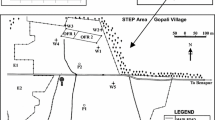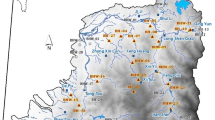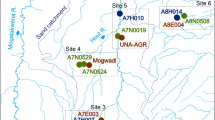Abstract
Seasonal rise of groundwater level manifests aquifer recharge through infiltration. Spatial variation of aquifer recharge within the same basin or terrain is a function of terrain heterogeneity governed by different hydrogeological factors. However, assessment of relations between water-level fluctuations (WLF) with various hydrogeological factors is not straightforward. In the present study, various hydrogeological factors that could influence aquifer recharge in the deformed crystalline Aravalli terrain of India have been analysed. Frequency plots have been used to assess the variations in WLF under different geological parameter classes. Seasonal WLF associated with these factors have been compared using various statistical parameters. Parametric and non-parametric statistical tests have been used to determine the statistical significance of fluctuation difference. The study infers that saturated thickness, lineament, lineament-intersection, and drainage beside surface elevation and well depth are the main geological factors influencing aquifer recharge in the Aravalli terrain. Median values under these factors are integrated and compared with the interpolated values of mean WLF at hypothetical well locations. They are found to closely resemble each other. This infers capability and applicability of the technique in identifying key factors governing WLF, and in predicting WLF at unexplored locations.













Similar content being viewed by others
References
Abbott MD, Stanley RS (1999) Modeling groundwater recharge and flow in an upland fractured bedrock aquifer. Syst Dyn Rev 15:163–184
Al-Abed N, Al-Sharif M (2008) Hydrological modeling of Zarqa River Basin–Jordan using the hydrological simulation program—FORTRAN (HSPF) model. Water Resour Manage 22:1203–1220. doi:10.1007/s11269-007-9221-9
Alley WM, Healy RW, La Baugh JW, Reilly TE (2002) Flow and storage in groundwater systems. Science 296:1985–1990
Anbazhagan S, Ramasamy SM, Das Gupta S (2005) Remote sensing and GIS for artificial recharge study, runoff estimation and planning in Ayyar basin, Tamil Nadu, India. Env Geol 48:158–170
Ben-Itzhack LL, Gvirtzman H (2005) Groundwater flow along and across structural folding: an example from the Judean Desert, Israel. J Hydrol 312:51–69. doi:10.1016/j.jhydrol.2005.02.009
Cook PG, Walker GR, Buselli G, Potts I, Dodds AR (1992) The application of electromagnetic techniques to groundwater recharge investigations. J Hydrol 130:201–229
Department of Science and Technology (DST) (1994) Resource atlas of Rajasthan. Government of Rajasthan, Jaipur
Dietvorst EJL, De Vries JJ, Gieske A (1991) Coincidence of well fields and tectonic basins in the Precambrian shield area of south east Botswana. Groundwater 29:864–877
Fetter CW (2001) Applied hydrogeology, 4th edn. Prentice Hall, Englewood Cliffs
Greenbaum D (1992) Structural influences on the occurrence of groundwater in SE Zimbabwe. In: Wright EP¸ Burges WG (eds) Hydrology of crystalline basement aquifers in Africa. Geological society special publication, vol 66, Geological Society Publishing House, Bath, UK, pp 77–85
Groundwater Department (GWD), Rajasthan (2000) Annual report. Government of Rajasthan, India
Hiscock K (2005) Hydrogeology: principles and practice. Blackwell, UK
Jaiswal RK, Mukherjee S, Krishnamurthy J, Saxena R (2003) Role of remote sensing and GIS techniques for generation of groundwater prospect zones towards rural development—an approach. Int J Remote Sens 24(5):993–1008
Knopman DS (1990) Factors related to the water-yielding potential of rocks in the Piedmont and Valley and Ridge provinces of Pennsylvania. U. S. Geological Survey Circular 538, Washington, DC
Knopman DS, Hollyday EF (1993) Variation in specific capacity in fractured rocks, Pennsylvania. Groundwater 31(1):135–145
Krishnamurthy J, Srinivas G (1995) Role of geological and geomorphological factors in groundwater exploration: a study using IRS LISS data. Int J Remote Sens 16(14):2595–2618
Krishnamurthy J, Mani A, Jayaraman V, Manivel M (2000) Groundwater resources development in hard rock terrain–an approach using remote sensing and GIS techniques. J Appl Geol 2(3/4):204–215
Mabee SB, Hardcastle KC (1997) Analyzing outcrop-scale fracture features to supplement investigations of bedrock aquifers. Hydrogeol J 5(4):21–36
Marani M, Eltahir E, Rinaldo A (2001) Geomorphic controls on regional baseflow. Water Resour Res 37(10):2619–2630
Mare′chal JC, Dewandel B, Subrahmanyam K (2004) Use of hydraulic tests at different scales to characterize fracture network properties in the weathered-fractured layer of a hard rock aquifer. Water Resour Res 40:W11508. doi:10.1029/2004WR003137
Moore ID, Burch GJ, Mackenzie DH (1988) Topographic effects on the distribution of surface soil water and the location of ephemeral gullies. Transaction of AAE 31:1098–1107
Moore RB, Schwarz GE, Clark SE Jr, Walsh GJ, Degnan JR (2002) Factors related to well yield in the fractured-bedrock aquifer of New Hampshire. U. S. Geological Survey Professional Paper 1660
Mukherjee S (1996) Targeting saline aquifer by remote sensing and geophysical methods in a part of Hamirpur - Kanpur, India. Hydrology Journal 19:53–64
Murthy KSR (2000) Groundwater potential in a semi-arid region of Andhra Pradesh–a geographical information system approach. Int J Remote Sens 21(9):1867–1884
Rejani R, Jha MK, Panda SN, Mull R (2008) Simulation modelling for efficient groundwater management in Balasore Coastal Basin, India. Water Resour Manag 22:23–50. doi:10.1007/s11269-006-9142-z
Roy AB (1988) Stratigraphic and tectonic framework of the Aravalli Mountain Range, In: Precambrian of the Aravalli Mountain, Rajasthan, India, Geological Society of India, Bangalore, pp 3–31
Sepúlveda N (2002) Statistical estimator of the spatial distribution of the water-table altitude. Groundwater 41(1):66–71
Siddiqui SH, Parizek RR (1971) Hydrogeological factors influencing well yields in folded and faulted carbonate rocks in central Pennsylvania. Water Resour Res 7(5):1295–1312
Siddiqui SH, Parizek RR (1972) Application of nonparametric statistical tests in hydrology. Groundwater 10:26–31
Siddiqui SH, Parizek RR (1974) An application of parametric statistical tests to well-yield data from carbonates of central Pennsylvania. J Hydrol 21:1–14
Sigda JM, Wilson JL (2003) Are faults preferential flow paths through semiarid and arid vadose zones? Water Resour Res 39(8):SBH 10.1–SBH 10.13
Singhal BBS, Gupta RP (1999) Applied hydrogeology of fractured rocks. Kluwer, Dordrecht
Sophocleous M (2005) Groundwater recharge and sustainability in the high plains aquifer in Kansas, USA. Hydrogeol J 13:351–365. doi:10.1007/s10040-004-0385-6
Taylor R, Howard K (2000) A tectono-geomorphic model of the hydrogeology of deeply weathered crystalline rock: evidence from Uganda. Hydrogeol J 8:279–294
Tsanis IK, Apostolaki MG (2008) Estimating groundwater withdrawal in poorly gauged agricultural basins. Water Resour Manage (in press)
Tucker GE, Catani F, Rinaldo A, Bras RL (2001) Statistical analysis of drainage density from digital terrain data. Geomorphology 36:187–202
Verma PK, Greiling RO (1995) Tectonic evolution of the Aravalli orogen (N–W India): an inverted Proterozoic rift basin? Geologic Rundsch 84:683–696
Waters P, Greenbaum D, Smart PL, Osmaston H (1990) Applications of remote sensing to groundwater hydrology. Remote Sens Rev 4(2):223–264
Author information
Authors and Affiliations
Corresponding author
Rights and permissions
About this article
Cite this article
Bhuiyan, C. Hydrogeological factors: their association and relationship with seasonal water-table fluctuation in the composite hardrock Aravalli terrain, India. Environ Earth Sci 60, 733–748 (2010). https://doi.org/10.1007/s12665-009-0211-5
Received:
Accepted:
Published:
Issue Date:
DOI: https://doi.org/10.1007/s12665-009-0211-5




